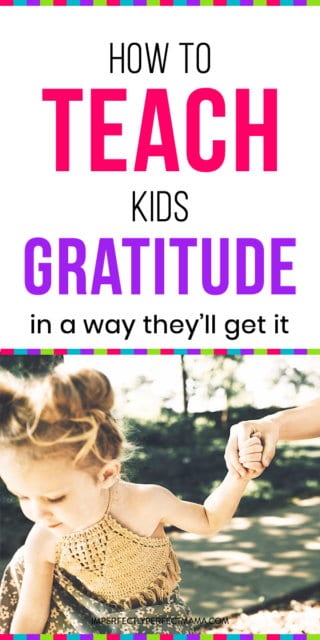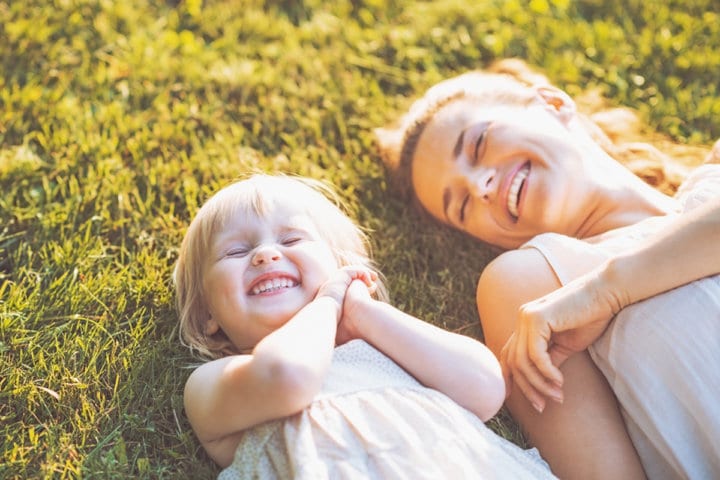We all want our kids to grow into happy and healthy adults.

It turns out there is a common thread among happy people, and it’s as straightforward as it is powerful.
It’s gratitude.
Leading gratitude researcher Robert A. Emmons undertook studies that highlight a link between gratitude and well-being. Emmons says “The practice of gratitude can have dramatic and lasting effects in a person’s life.”
Similarly, research from Northeastern University demonstrates people who feel grateful about regular everyday things are more patient and can make better decisions (than those who don’t feel grateful).
A way to help create patient humans with better decision making capability? Sounds just like what this world needs!
But how do you instill a sense of gratitude in children without it feeling superficial or forced? How do you do it in a way they’ll connect with and understand?
Lucky for us, there are simple approaches you can use to foster gratitude in children authentically.
Don’t Tell Them, Show Them

We know our kids learn from the behaviors we model. This reality is pesky when we have a parenting-fail like dropping a big fat swearword when you step on a piece of Lego.
But you can make use of this inbuilt mimicking feature! Kids are sponges, and they soak up everything we have to offer.
One effective way to model this for your kids is to be open and share what you feel grateful for (out loud). We’re not necessarily talking about big life-changing moments or gestures. Regular everyday moments of gratitude can be potent, are illustrative, and they add up. You don’t have to use the word gratitude — share the essence of how you feel in a way your kids can relate to, for example:
- I’m so thankful Grandma could help us out today, it made things so much easier!
- Isn’t it great we can all have dinner together
- Aunty Alex is the best! I always feel good when I see her
- I’m so pleased we have sunny weather today. I can’t wait to get outside and feel some sunshine
- I love having a pet dog; having her around makes me feel good (even though she’s a little smelly)
The flipside of all this is if you don’t genuinely feel a sense of gratitude in your own life, you’ll be hard-pressed to teach it to anyone else – kids can see a fake a mile off.
The good news? It’s never too late to bring gratitude into your own life. Your little people can learn and practice with you.
Introduce a Child-Friendly Gratitude Ritual
Child-friendly gratitude based rituals are effective ways cement a sense of appreciation in day-to-day life.
Like all things child related the trick is it can’t be boring or too abstract (or go on for too long).
A shared meal is a prime opportunity to share some grateful goodness.
Doctor Susan Carland shared a great example of how to do this with Mamamia. Dr. Carland explained a simple game her family uses at dinnertime, “It’s called 3BT which stands for three beautiful things. Let’s find three good things in our day no matter what they are, big or small, exciting or mundane.”
So using this idea, going around your table everyone gets to share three beautiful moments from their day. You can explain it can be a moment that left them feeling good, or amazed them or made them laugh. As we are talking about tiny humans here you might end up with some like:
- Playing in the sandpit with the big trucks
- When Adam laughed snot came out of his nose, and it was funny
- I saw two ladybugs on the same plant at lunchtime!
Sure you might not share the same perspective on Adam’s experience, but it’s a start.
Another approach might be creating a child-friendly version of a gratitude journal.
You could give your child a little visual diary (notebook with blank pages) and ask them to draw a picture showing something that made them feel good. It could be something you do together each weekend or on a particular night of the week.
The trick to all of these ideas being useful is that you make them part of your routine. There’s a ripple effect — the more you practice, the more natural it feels to express gratitude. Over time this shifts your focus and brings feeling grateful into your day-to-day.
Appreciate Beauty Kid-Style

Noticing beauty and wonder in the little things around us helps foster gratitude. It also teaches us to be mindful. It’s possibly even something our children can help us with:
- “Look at the red leaf!”
- “Check out the cloud! It looks like you with a cranky face.”
- “Wow Mom, look at the patterns the kettle steam is making in the air.”
Sure it can be tedious if you’re trying to get out the door (or do anything or go anywhere in less than 2 hours), but this is mindfulness playing out naturally, and it underpins being present and appreciating what’s around you.
Getting out into nature it one of the easiest ways to appreciate beauty in the world. Simple games work a treat:
- Find three amazing things in the garden
- A beautiful flower or a fantastic insect hunt
- Cloud spotting
- Bird spotting
- Which flower smells the best contest
Don’t hesitate to point out sunsets or bird calls. Take time to notice the leaves and ladybugs. You might boost your count too!
Time to Get All Grateful
Engaging and straightforward child-friendly gratitude practices are easy to slip into everyday life and can benefit the whole family. Consciously sharing your moments of gratitude with your children can encourage the same habit and positive outlook, and helps build happy and grateful adults.
Instilling a sense of gratitude in our children is a gift. It’s never too early (or too late) to get started.
Do you use gratitude rituals with your kids? What works for you?




4 Comments